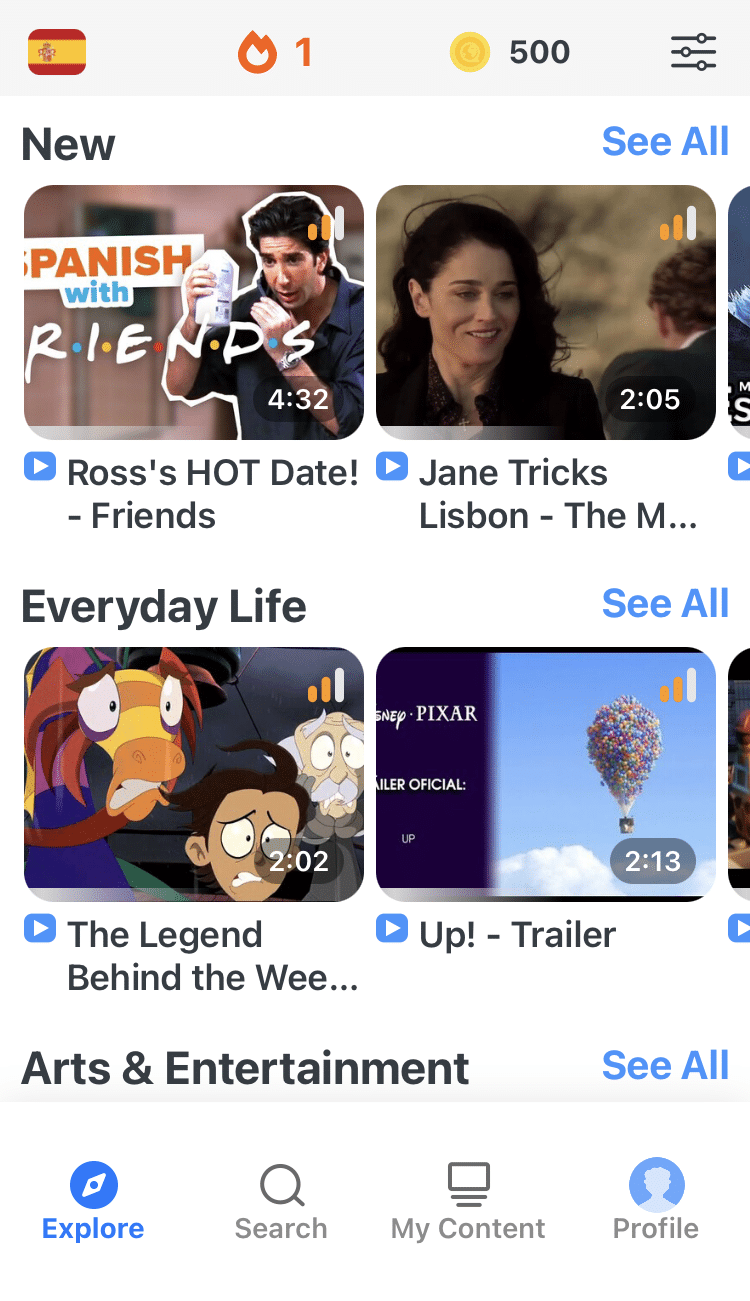
16 Tips for Learning Two Languages at Once
It doesn’t matter how much you love languages—learning a few at once can be tricky.
But turns out, there’s a lot of advantages to learning multiple languages at once.
Is your appetite for language learning so voracious that one language at a time simply isn’t enough to keep you satisfied, or maybe you’re just looking to add some spice to your language learning?
Either way, here are 16 tips to help you get started learning multiple languages at once—without having your brain explode.
Contents
- How to learn two languages at the same time
- 1. Learn languages that are different
- 2. Pair more and less familiar languages
- 3. Consume media in all your languages
- 4. Study new languages in your stronger language(s)
- 5. Give your target languages separate “identities”
- 6. Consider choosing a “priority” language
- 7. Decide how much time to spend on each language
- 8. Cultivate equal relationships with each target language
- 9. Mix up your flashcards to learn languages simultaneously
- 10. Learn the same topics in multiple languages at the same time
- 11. Practice multiple languages at once by translating between them
- 12. Live in a place that speaks at least one of your languages
- 13. Maintain a multilingual social network
- 14. Use your languages at work
- 15. Have at least one hobby related to each language
- 16. Be adaptable in your language learning techniques
- Benefits of Learning Multiple Languages at Once
- And One More Thing...
Download: This blog post is available as a convenient and portable PDF that you can take anywhere. Click here to get a copy. (Download)
How to learn two languages at the same time
1. Learn languages that are different
On the surface, learning two similar languages at the same time might seem like a good idea.
The truth, though, is that it is never a good idea to study two mutually intelligible (or even moderately similar) languages at the same time.
When learning two languages simultaneously, the rule is to do everything you can to minimize the confusion factor–the chance of getting words and grammar from the languages mixed up.
And learning two languages that resemble each other ensures that confusion is all but inevitable. It’s just not a good idea.
So if you’re already learning Spanish, put the Italian on hold and go for Finnish.
If the two languages you’re learning use different scripts, all the better. Spanish and Chinese are a great combination–they have nothing in common, and if you learn them as an English speaker, you’ll have the world’s three most common languages at the tip of your fingers.
But if you opt for two languages that have little in common, you’ll paradoxically be gaining a broader perspective and making your life easier at the same time.
2. Pair more and less familiar languages
One way to simplify the process of learning two languages at once is to choose one language that’s more familiar to you and one that’s less familiar to you.
If you already speak some Italian, for example, you might choose to learn French. The idea is that much of the structure of Italian and some of the vocabulary will transfer over to French.
For your second language, you might select Russian, which is completely different from both French and Italian. That way, you’ll be learning Russian from scratch and learning another Romance language, rather than learning two languages from scratch.
Note that this approach is different than learning Italian and French at the same time, because:
- It involves building off of a language you’ve already internalized (in this example, Italian).
- It helps minimize the confusion factor for your new languages—French becomes “the one like Italian” and Russian is “the other one” (rather than two unknowns).
If you don’t know any languages other than English, you can still make use of this tip. Choose one language that’s easier for English speakers to pick up and one that’s generally harder, like Dutch and Korean, for example.
Check out this site to get a sense of the easiest and hardest languages for English speakers so you know what you’re getting into.
3. Consume media in all your languages
Media is your best friend for maintaining and improving your language skills. The good news about reaching a high level of fluency is that once you’re there, watching a movie or reading a book in your target language is fun, not work.
If you’re on a budget, libraries often have a surprisingly wide selection of books in other languages, too. Foreign language news sites are also a fabulous way to stay current on what’s happening in countries where your target language is spoken.
If you want both language immersion and language instruction, you can try using FluentU.
FluentU takes authentic videos—like music videos, movie trailers, news and inspiring talks—and turns them into personalized language learning lessons.
You can try FluentU for free for 2 weeks. Check out the website or download the iOS app or Android app.
P.S. Click here to take advantage of our current sale! (Expires at the end of this month.)
4. Study new languages in your stronger language(s)
Once you’ve attained a certain level of comfort in a non-native language, you can learn subsequent languages through it. This will both solidify your knowledge of the stronger language and help you get ahead in the new language.
For instance, imagine you’re a native English speaker with a pretty comfortable grasp of French. To then learn Chinese, you might listen to a podcast for French speakers learning Chinese, or get a French-Chinese dictionary instead of an English-Chinese one.
This technique is called laddering, and it’s extremely useful for keeping your brain in “foreign language mode.”
Just note that it’s usually only possible if both of your languages are relatively common. Don’t expect to use Finnish to learn Bengali, for example—there just won’t be enough language material out there.
5. Give your target languages separate “identities”
A big part of minimizing the confusion factor boils down to giving the two languages you’re learning strong, clear identities in your mind.
Perhaps the best way to do this is through immersion—the more you use a given language, the more you internalize it as something with an identity unto itself. We’ll talk more about this later.
You can also try color-coding your language learning materials to reinforce the separate identities of the two languages.
For instance, if you’re learning Spanish and Chinese, try making all your Spanish flashcards red and all your Chinese flashcards blue. Then, optionally, remind yourself every day:
Spanish is red,
Chinese is blue,
I will learn both,
If it’s the last thing I do!
6. Consider choosing a “priority” language
If you still aren’t sure about taking the leap and going for two (or more) languages at once, you can set a “priority” language to which you’ll devote a larger amount of your time and energy.
That way, you can shoot for two languages but still know you’ll come away with at least one under your multilingual belt.
Even if you’re absolutely sure that you’re in it for two languages, setting a priority language is an effective way of minimizing the confusion factor.
Plus, progressing more quickly at one of the two languages you’re working on will help stave off the feeling of running in place that can occasionally creep up on two-at-a-time language learners. It’s easier to stay motivated when you can see your progress.
7. Decide how much time to spend on each language
Learning multiple languages at once only works if you do some planning in advance.
Before you start studying, figure out exactly how you’re going to divide your time between the languages you’re tackling. If you have a priority language, devote most of your time to that one, and choose to study it during the times you have the most energy and focus.
Tracking your hours and setting a regular study routine will help you stay organized.
You should also be aware that you’re in for a bigger learning curve than you would be if you were targeting a single language. Things will just take longer.
8. Cultivate equal relationships with each target language
Your goal should be to become bilingual in each individual language you intend to learn.
Have a concrete reason for learning each language, such as:
- Learning Spanish so that you can understand Flamenco lyrics
- Learning Russian to communicate with your in-laws
- Learning French because you’d like to study cuisine in France
Having a relationship or connection to a language means you have a strong, emotional desire to be able to use the language. It also means that your reasons for learning the language should be constants in your life, rather than motivations that are likely to dry up after a year or two.
9. Mix up your flashcards to learn languages simultaneously
If you like your language learning with a large side of flashcards, take some of your flashcards for both languages and mix them together so you’re practicing two or more languages at the same time.
Now, you might be thinking: “But didn’t you say it’s important to minimize the confusion factor and keep my languages separate?”
Well, it is important to pick two very different languages to avoid confusion, but the act of switching quickly between the languages you’ve picked actually helps you keep them separate.
Changing from one language to the other at the drop of a dime will help you build the necessary flexibility for multilingual skills, allowing you to alternate back and forth without getting overwhelmed—a skill that will make you a more effective two-in-one language learner.
10. Learn the same topics in multiple languages at the same time
As you plan your studies, experiment with taking things a step further by learning the same thing across both or all of your languages.
It works because of a psychological effect known as “priming.” Priming has to do with how the things you think about now affect the things you will think about in the near future.
For example, if I say the word “cat” and then ask you to immediately list ten words that come to mind, it’s more likely that “dog” would be one of those words than “potato,” because dogs and cats are more closely related and you’ve been primed to think about things related to cats.
Similarly, if you learn the word for “cat” in Spanish and then learn the same word in Chinese, you’ll likely find that the Chinese word for “cat” sticks in your memory more easily.
Use this to your advantage and plan your language learning in a way that allows you to study smarter, not harder!
11. Practice multiple languages at once by translating between them
Besides giving you a chance to work on both languages at once, this exercise helps get you “thinking” in the languages you’re learning rather than constantly returning to your native language.
When learning one language at a time, you run the risk of relating everything back to your native language and thereby making that language your permanent point of reference. That means your new language becomes an “extension” of your native tongue rather than something you internalize on a deep, intuitive level.
But when you’re learning two languages at the same time, you can practice translation by simply translating between the two new ones you’re learning!
You can even up the ante by translating across different languages and linguistic mediums. If you’re learning Spanish and Chinese, for example, try writing a passage in Spanish and then verbally translating it into Chinese.
12. Live in a place that speaks at least one of your languages
Living abroad makes practicing language easier because you’ll likely need it to do simple, daily tasks and interact with other people.
It’s also easier to use the laddering technique if you’re living abroad. When I lived in France, for example, I took both a Chinese class and an Arabic class, but I learned some French in both classes as well.
You may also consider moving to a multilingual city, either abroad or in your own country. If you plan correctly, this could immerse you in both (or several) of your target languages at once.
In Strasbourg, France and Fribourg, Switzerland, for example, both French and German are spoken and would be ideal for someone looking for immersion in both languages. Alternatively, a multilingual city like Brussels or New York will make opportunities to practice unrelated languages easier to come by.
13. Maintain a multilingual social network
If you’re trying to improve and maintain various languages, it’s essential to make friends who speak your target languages. This will allow you to practice while socializing, and it provides an emotional connection to the language that makes it more likely you’ll continue making progress in the long haul.
Here are some ideas for meeting and befriending speakers of other languages:
- Go to language-related events. You can find organized get-togethers on Meetup.com or through various Facebook groups.
- Attend events at local cultural organizations. The Cervantes Institute, Confucius Institute or the Alliance Française, for example, all hold events at the local level.
- Seek out immigrant communities who speak your target languages. Try attending religious services, doing your grocery shopping at ethnic stores and/or living in a neighborhood with a lot of people who speak your target language.
14. Use your languages at work
If you’re able to make your work time do double duty as language practice, you’ll have that much more time to practice, but this is generally only possible if you speak your target languages quite well.
There’re many industries where you’d be especially likely to use foreign languages such as tourism, translation and interpreting and journalism.
And it’s probably possible to use your target language as part of most professions, honestly. For example, you could easily build a reputation as the Spanish-and-Chinese-speaking real estate agent in your area and work with immigrant communities who speak those languages.
Using languages at work may require a little creativity, but is definitely doable and can even benefit your career.
15. Have at least one hobby related to each language
A related hobby provides a crucial part of your emotional connection to the language.
Hobbies are also a potent reminder that learning a language is a means of connecting with another culture and communicating with people.
These are some examples of hobbies that can be enhanced by language learning:
- Cooking. Watch cooking shows in French, study cuisine in Chinese or read Russian cookbooks. All languages have a matching cuisine, and if you know the language, you’ll have more resources when it comes to learning about the food.
- Music. Music is another versatile hobby when it comes to language learning. You might take erhu lessons in Chinese, guitar lessons in Spanish or voice lessons in German.
- Dance. Flamenco teachers in Spain almost never speak English, so knowing Spanish will help you immensely. Arabic-speaking belly dancers will have more success finding a teacher in the Middle East than non-speakers. And wouldn’t samba lessons in Brazil be great—and that much greater if the classes were in Portuguese?
16. Be adaptable in your language learning techniques
You can and should play around with different study methods as you’re learning multiple languages at once. Use flashcards for vocabulary, listen to podcasts and work through textbook exercises. Find language learning apps that cater to your target languages.
Then, take note of how things are going—you could even do this in one or more of your target languages by keeping a journal. Review your notes from time to time and adjust your language learning roadmap accordingly.
The more adaptable you are, the easier it is to learn languages—and the more you learn languages, the more adaptable you get!
Benefits of Learning Multiple Languages at Once
It’s good for your brain
When you speak more than one language, your brain needs to recognize, distinguish and analyze the different linguistic patterns, intonations, vocabulary, grammatical rules and idiomatic expressions of different languages.
Scientists found that learning a foreign language changes the structure of language-related brain regions
Learning multiple languages can also improve memory as well. Psychologists discovered that children who grow up bilingual have faster, more accurate and more robust working memory.
It’s also been known that just speaking a second language can delay the onset of Alzheimer’s Disease. One study has shown that being bilingual may delay the onset of dementia for a good 5.1 years.
It saves precious time
Wouldn’t life be much easier if you could communicate while abroad in France or Spain? That way you’d make the most of your 5-day vacation instead of spending half of it looking for some dingy rest room.
If learning a second language is such a time saver, how about learning a third and a fourth language? Imagine how much of the world you could navigate!
Doing multiple languages at the same time (simultaneously) saves time because, in a way, you’re multitasking. Instead of getting fluent in one language in 1.5 years, you become fluent in 2 languages in 2 years.
It lets you study more languages faster
One advantage of learning multiple languages at once is that you can play the languages off of one another. You can take notice of (and better remember) the eccentricities of a language by noting its similarities or differences with another tongue.
An example of this is the many cognates shared by romance languages. Cognates are words in different languages that share similar spelling, meaning and pronunciation.
In short, knowing a second language puts you at a definite advantage in learning a third or a fourth one.
It keeps you from getting bored
Another advantage of learning languages simultaneously is that it keeps you alive and alert on the task.
You don’t have to bury yourself for months on end in a single language. There always comes a point in any language learner’s endeavors when they finally plateau and get sick of the lessons. You can either barrel through that phase, or you can refresh yourself by getting into another language.
Don’t think of it as quitting, think of it as productively redirecting your language learning energies. What’s important is that you can have several language “mistresses” on the side. It keeps things interesting. This works especially well for languages that are so different, they are like a breath of fresh air.
It opens new opportunities
Being multilingual compounds your prospects and gives you a sharp edge in the job market.
Over the next decade, Spanish and Chinese speaking skills will be one of the most critical skills sought by recruiters. Moreover, a great number of international corporations are no longer based in English-speaking countries.
On the romantic end, speaking your love’s language brings you to their reality of things. It promotes understanding between you and your significant other.
So take the tips listed here, go for it, and let us know if you find any cool new tricks while you’re at it!
Download: This blog post is available as a convenient and portable PDF that you can take anywhere. Click here to get a copy. (Download)
And One More Thing...
If you dig the idea of learning on your own time from the comfort of your smart device with real-life authentic language content, you'll love using FluentU.
With FluentU, you'll learn real languages—as they're spoken by native speakers. FluentU has a wide variety of videos as you can see here:
FluentU has interactive captions that let you tap on any word to see an image, definition, audio and useful examples. Now native language content is within reach with interactive transcripts.
Didn't catch something? Go back and listen again. Missed a word? Hover your mouse over the subtitles to instantly view definitions.
You can learn all the vocabulary in any video with FluentU's "learn mode." Swipe left or right to see more examples for the word you’re learning.
And FluentU always keeps track of vocabulary that you’re learning. It gives you extra practice with difficult words—and reminds you when it’s time to review what you’ve learned. You get a truly personalized experience.
Start using the FluentU website on your computer or tablet or, better yet, download the FluentU app from the iTunes or Google Play store. Click here to take advantage of our current sale! (Expires at the end of this month.)






